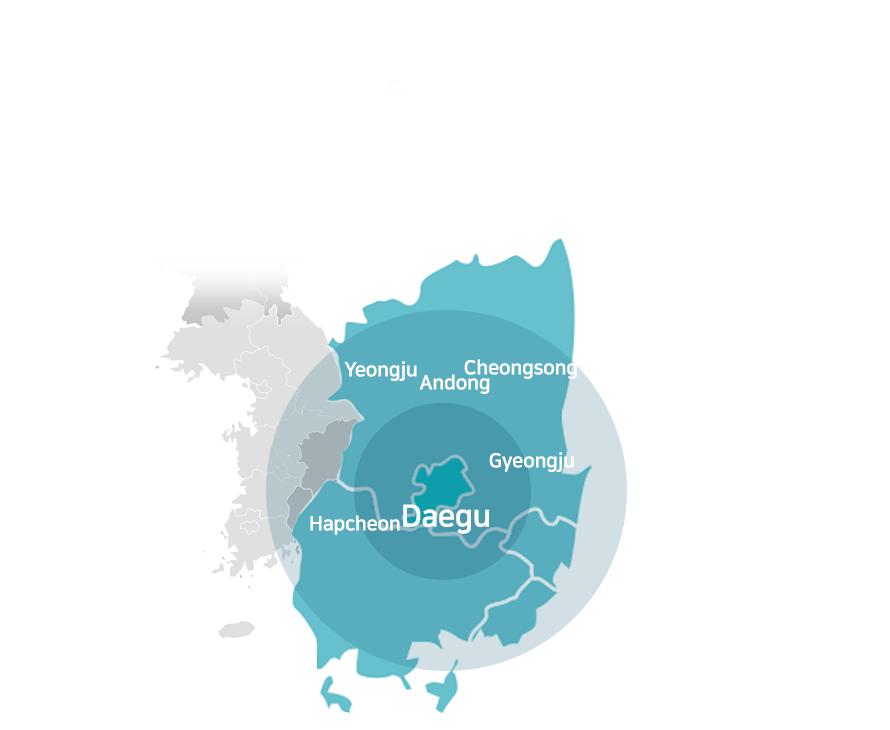Daegu is a great city for visiting sites and attractions officially recognized by UNESCO. The Archives of the National Debt Redemption Movement, a documentary heritage site included in the Memory of the World Register, and Dodongseowon, a world heritage site, are both located in Daegu. Confucian, Buddhist, and Gayan world heritage sites, and a global geopark are also located within an hour from Daegu. The city is loved by international conference participants as a city getting a full experience of Korean culture.
Andong
Andong
Cheongsong
Gyeongju
Gyeongju
Gyeongju
Daegu
Daegu
Hapcheon
Yeongju












Andong: Hahoe Village
Hahoe Village is one of the most famous folk villages in Korea. Surrounded by the Nakdonggang River, the village is home to descendants of the Ryu clan of Pungsan, which still makes up 70 percent of the villagers. The village became even more famous after Queen Elizabeth of England visited on April 21, 1999 and President George H. Bush of U.S.A. in 2005. The village has many cultural treasures and important cultural materials, earning the village the designation as National Folklore Cultural Heritage No. 122 in 1984. Hahoe Masks, National Treasure No. 121, is also an important feature of the village.
Andong: Dosanseowon Confucian Academy & Byeongsanseowon Confucian Academy
Before it became a Confucian academy, Byeongsanseowon Confucian Academy was originally located in Pungsang-hyeon under the name Pungakseodang School, which was used as an educational institution since the Goryeo dynasty by a political party known as the Sarim Party. It was moved to its current location in Byeongsan by a well-respected Confucian scholar named Yu Seong-nyong, penname Seoae, in 1572.
In terms of architecture, Dosanseowon Confucian Academy complex can largely be divided into Dosanseodang compound and Dosanseowon compound. Dosanseodang area consists of living quarters and lecture halls where Toegye Yi Hwang, an eminent Confucian scholar, lived and taught his students. Dosanseowon was built after Toegye Yi Hwang passed away by his followers in legacy of his teachings as well as to pay respects to the deceased.
Cheongsong: Global Geopark
Cheongsong is a geopark portraying harmony of nature, geographical features, traditions and culture. Visitors can observe unique characteristics of volcanic rock, sedimentary rock and metamorphic rock. Also, peculiarly shaped cliffs, canyons, waterfalls, Eoreumgol Valley, Yaksutang, dinosaur footprints and more come together to form its picturesque landscapes.
Gyeongju: Yangdong Village
Gyeongju Yangdong Village is Korea’s largest traditional village, showcasing the traditional culture of the Joseon Dynasty and the beautiful natural surroundings. Thanks to its many cultural heritages, including treasures, national treasures, and folklore materials, the entire village has been designated as a cultural heritage site. Many people have visited this village to see its wealth of cultural heritages and scenic surroundings. Charles, Prince of Wales, visited this village in 1993. Seolchangsan Mountain and its four spines of mountains can be seen beyond the village. Approximately 160 old houses and 500-year-old thatched-roof cottages are nestled within the valley. Fifty-four of these homes, are over 200 years old and have been excellently preserved in their original state, offering a rare opportunity to view a variety of unique Korean traditional houses in person.
Gyeongju: Seokguram Grotto and Bulguksa Temple
Seokguram is a stone cave enshrining a statue of the Buddha. and Bulguksa is a temple site. They are both perceived as masterpiece artworks of Koreans from the ancient Silla Dynasty representing zeal and the artistic soul.
Gyeongju: Historic Areas
Visitors can appreciate the artistic brilliance from thousand-year old Buddhist buildings, daily life artifacts and the historic sites of the Silla Dynasty. Sculptures, pagodas, royal tombs and fortresses are found all around the 5 different regions of Namsan Mountain, Daereungwon Ancient Tombs, Hwangnyongsa, and Myeonghwalsan Mountain.
Daegu: Dodongseowon Confucian Academy
Dodongseowon Confucian Academy was first established by Confucian scholars in 1568 at the eastern base of Biseulsan Mountain, but was burnt down during the Imjin War (1592-1598). In 1605, the school was reconstructed on its current site and was renamed Borodongseowon. In 1607, the name was changed to Dongdoseowon. "Dongdo" means that the teachings ("do") of Confucianism come from the East (dong in Korean). Dodongseowon is one of the 47 major Confucian academies that was not affected by Heungseon Daewongun's order to eliminate Confucian academies.
Daegu: Archives of the National Debt Redemption Movement
A voluntary movement erupted at the brink of Japanese colonization when Imperial Japan imposed 13 million Korean won to the Korean Empire. The movement intended to repay the country's debt through individual donations and a total of 2,475 donation records are kept in the memorial hall. The movement received much attention for its economic model represented by solidarity among people and the practice of responsibility, which influenced National Debt Redemption Movements in other countries such as China, Mexico and Vietnam.
Hapcheon: Haeinsa Printing Woodblocks of the Tripitaka Koreana
The Tripitaka Koreana was created in the 13th century. It has 80,000 pages and exemplifies the epitome of the precision publication technique. It is considered to be the oldest, the most precise and the most perfect Buddhist Tripitaka in the world.
Yeongju: Buseoksa Temple
Buseoksa Temple was built in 676, during the reign of King Munmu (661-681) of the Silla Kingdom (57 BC-AD 935). The temple was founded by Great Monk Uisang (625-702) upon orders from the king. When Uisang was studying in the Dang dynasty of China, he heard of a plot by the Dang dynasty to attack Silla. Upon hearing this, he hurried home and passed the message along to the king. The temple was created to pray for protection of the country.